Unpretentious sweet and sour variety of honeysuckle Princess Diana
Princess Diana is a variety of edible honeysuckle, bred by a Russian plant breeder and successfully combining high yield, pleasant taste of large fruits and decorative appearance of the bushes. Let's consider the advantages, disadvantages and agrotechnical requirements of the variety.
Description of the honeysuckle variety
Princess Diana - honeysuckle domestic selection. The berries are characterized by their large size and pleasant sour-sweet taste. 100 g of fruit contains 14.7% dry matter, 9.3% sugar, 3.4% organic acids, 1.7 mg pectin and 0.15% carotene.
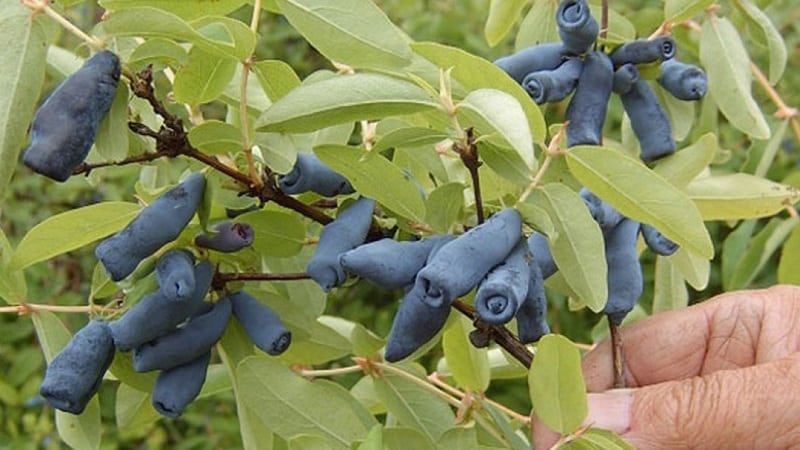
Origin and development
The variety was bred at the end of the 20th century. Russian plant breeder L.P. Kuminov, who, at his own summer cottage in the Moscow region, carried out more than a dozen crossings of wild honeysuckle seedlings from the forests of the Magadan region.
Characteristic
During the flowering period, large white flowers appear on the bushes, arranged in pairs.
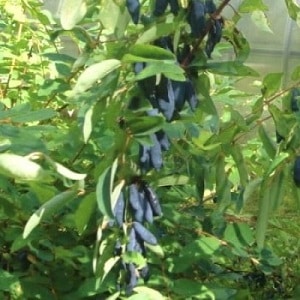 The berries are multi-seeded, oblong-oval, large. They reach 4-5 cm in length, 1–1.2 cm in diameter, weigh 1.5–2.7 g. The surface is slightly lumpy, the skin is thin, of a rich violet-blue color.
The berries are multi-seeded, oblong-oval, large. They reach 4-5 cm in length, 1–1.2 cm in diameter, weigh 1.5–2.7 g. The surface is slightly lumpy, the skin is thin, of a rich violet-blue color.
The pulp is tender, moderately juicy, medium dense. The aroma is weak, the taste is sweet, with a slight sourness, without astringency or bitterness.
Features of application
Princess Diana berries are suitable for consumption in fresh, frost and preservation (preparing jams, juices, preserves).
Reference. After processing, the fruits do not lose their taste and beneficial properties.
Decorative bushes This variety of honeysuckle is used in landscape design for decorating gardens and local areas.
Ripening period, yield and fruiting
This is an early ripening variety - the harvest ripens in the second half of June.
The bushes begin to bear fruit in the 2nd year after green cuttings. On average, 4 kg of berries are harvested from a plant.
Resistance to diseases and pests
Culture is susceptible ramularia, cercospora, powdery mildew, attacks of aphids, mites, scale insects, leaf-eating caterpillars and fingerwings.
Resistance to cold and drought
The bushes can withstand frosts down to -15°C and winter changes in air temperature.
The variety prefers moderate moisture. With a lack of moisture, productivity decreases, and excessive watering and waterlogging of the soil lead to rotting of the root system.
Climate requirements
Despite good resistance to frost and drought, Princess Diana is not suitable for cultivation in the Urals, Siberia and others regions with extreme weather conditions. The variety is suitable for areas with a temperate climate and short frosts.
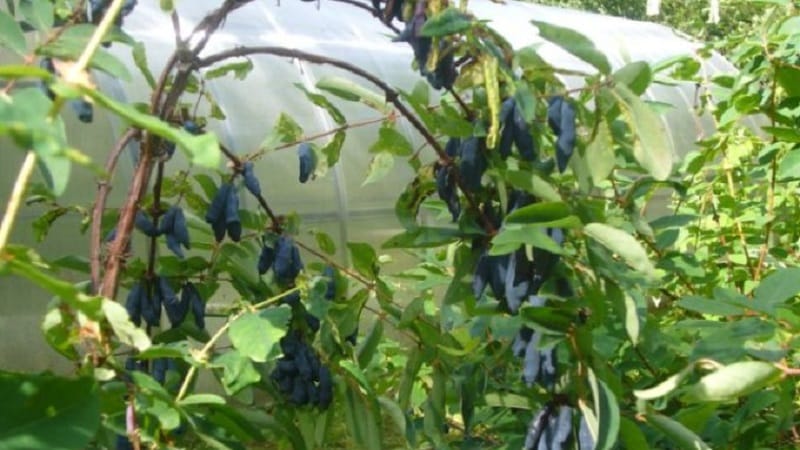
Advantages and disadvantages of the variety
The main advantages of Princess Diana:
- dessert taste of berries;
- large fruit;
- high productivity;
- ability to adapt to different climatic conditions;
- lack of tendency to shed berries;
- unpretentiousness.
Disadvantages of the variety:
- average degree of frost resistance;
- lack of immunity to a number of diseases and pests;
- need for pollinators.
Differences from other varieties
A comparison of Princess Diana with other early ripening varieties is presented in the table:
| Variety | Berry weight, g | Taste | Berries shape | Productivity, kg/bush |
| Princess Diana | 1,5–2,7 | Sweet and sour | Oblong-oval | 4 |
| Enchantress | 1–1,3 | Sweet | Pear-shaped or ellipsoid | 1,8–2,8 |
| Vasyuganskaya | 0,8–1,2 | Sweet and sour | Elongated, pitcher-shaped with a flat top | Up to 2.5 |
| Tomsk | 0,8–1 | Sweet and sour | Drop-shaped or cylindrical | 2,5 |
Agricultural technology
For successful cultivation of crops, it is important to observe a number of rulesconcerning the selection and preparation of a site, planting bushes and caring for them.
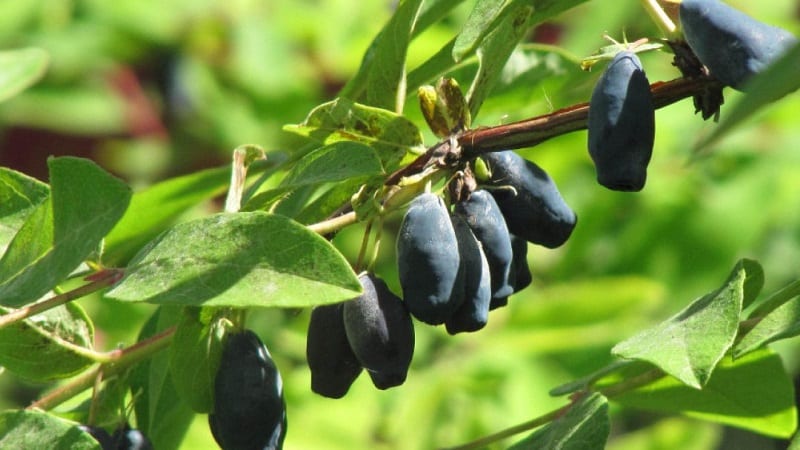
Choosing a place in the garden
To plant Princess Diana, choose an open, well-lit place, protected from gusty winds and drafts.located at least 5 m from any tall plants. The variety is shade-tolerant, but lack of light negatively affects the yield.
Reference. The crop is not grown on black soil, in acidic soil and soils with low moisture capacity.
To eliminate the risk of root rot Due to swampy soil and stagnant moisture, a place is chosen on the site that is not located in a lowland, with a groundwater level of at least 1 m.
Preparing for landing
Suitable for planting are 2-year-old seedlings without signs of pest or disease damage., with intact bark, elastic, moist root system and at least 3 root branches.
Before planting, seedlings are sprayed with a 2% solution of copper sulfate. or “Fitosporin”, and the rhizome is soaked for a day in a thick solution of purified clay.
10–15 days before planting, the soil on the site is cleared of weeds, plant debris and other debris. For every 1 m² of land, add 10 kg of humus, 250 g of crushed charcoal, 100 g of superphosphate and 25 g of potassium nitrate. The soil is dug up 30 cm deep and leveled.
Soil requirements
The variety grows well in fertile, loose and light soil with good aeration, moisture permeability and neutral acidity. A suitable option is fertilized sandstone and loam.
Dates, scheme and rules of planting
Honeysuckle planted in early spring, before buds open (late March - early April), or autumn (mid-October).
Planting scheme:
- Planting holes are dug on the site with a depth and diameter of 40–50 cm.
- They form mounds about 15 cm high from a nutrient mixture (a bucket of humus, half of the excavated soil, 100 g of potassium salt, 1 tbsp. wood ash and 100 g of double superphosphate).
- Seedlings are placed on them, spreading the roots along the slopes.
- Cover the plants with soil so that the root collar deepens 4-5 cm.
- Water the plantings and mulch the soil with humus or straw.
Distance between bushes should be 2–2.5 m.
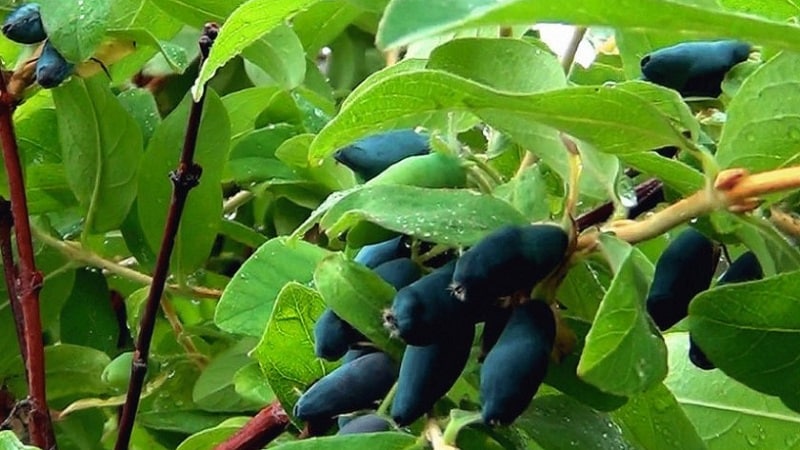
Features of cultivation
With proper preparation of the site and seedlings, during the first 2 years after planting, honeysuckle is only watered Once every 2–4 weeks, spending 5 liters of water on each bush. Starting from the 3rd year, watering is carried out 3-4 times per season at the rate of 10-12 liters of water per plant. During dry periods, the frequency of irrigation is increased.
After each watering or rain, the soil is loosened to a depth of 5–7 cm to improve its moisture permeability and aeration. At the same time, weeding is carried out.
Fertilizers are applied according to the scheme:
- at the beginning of spring - once every 2-3 years: 10 liters of urea solution (50 g per 10 liters of water) for each bush;
- after 2 weeks - 10 kg of humus and 200 g of wood ash for the plant;
- annually before flowering - complex mineral fertilizers for fruit bushes (Joy, “Zdraven”, “Gera”, Fertika).
Every 2nd season, 5-6 years after planting, sanitary pruning - remove all old, damaged and dry shoots. Plants aged 12–15 years are subjected to anti-aging pruning - the bushes are cut off completely, leaving only the basal rosette.
Pollinators
This is a cross-pollinated plant, so to obtain a harvest, at least 2 pollinating varieties are planted nearby. The Best Pollinators for Princess Diana:
- Nizhny Novgorod early;
- Altair;
- Enchantress;
- Kamchadalka;
- Karina.
Disease and pest control
Diseases and pestsdangerous for Princess Diana:
| Disease/pest | Signs | Fighting methods |
| Ramulariasis | Leaves and shoots become covered with various spots. | Spraying with “Fundazol”, “Energy”, “Acrobat”, “Quadris”. |
| Cercospora | ||
| Powdery mildew | A white powdery coating appears on the underside of the leaves. | Treatment with Topaz or 0.5% soda ash solution. |
| Aphid | Leaf blades turn yellow, become deformed and fall off. | Treatment of bushes with “Aktellik”, “Confidor”, “Aktara”, “Rogor”. |
| Ticks | ||
| Shields | ||
| Leaf-eating caterpillars | Pests gnaw honeysuckle leaves. | The caterpillars are collected by hand, the bushes are sprayed with garlic or pepper infusion, Decis and Inta-Vir preparations. |
| fingerwings | The berries shrivel and fall off. | Spraying with Inta-Vir. |
To combat insects or diseases, plants are treated twice with an interval of 2 weeks, for prevention - once a month.
Important! The last spraying is carried out at least a month before harvesting.
Preparing for winter
At the end of autumn the soil is cleared of fallen leaves and other plant debris, and the tree trunk circle is mulched with humus (layer thickness - at least 10–15 cm).
The branches of bushes are covered with spunbond, hay, straw or other material that allows air to pass through well.
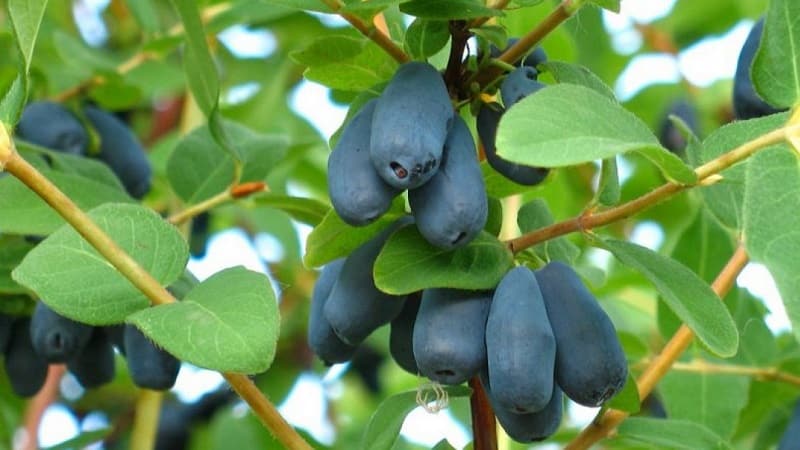
Reproduction
Honeysuckle propagated by seeds or cuttings.
In the first case planting material is collected from the most ripe fruits, sown in a container with a fertile, loose substrate and germinated at room temperature during the winter. In the spring, the most active and strong seedling is selected and transplanted into open ground.
For cuttings in March, several young shoots are cut from a 4- or 6-year-old bush and cut into pieces 20 cm long so that each has at least 3 buds. The cuttings are germinated at room temperature and transplanted into garden beds in mid-May.
Difficulties in growing
Problems with cultivating this variety:
- slow development of bushes, low yield, formation of small berries - the bushes do not have enough light;
- wilting, yellowing, deformation of leaves - a sign of pest attack;
- the formation of a white powdery coating on the leaf blades is a symptom of powdery mildew that developed as a result of planting honeysuckle in acidic soil.
Harvesting
The harvest is harvested from the second half of June to mid-August. The fact that the berries are ripe is indicated by the characteristic rich purple-blue color of the skin. The fruits are removed from the bushes on a dry, windless day and placed in plastic or wooden containers.
In the refrigerator or cellar at a temperature of +5...+15°C, honeysuckle is stored for 1-2 weeks, frozen at -20...-25°C - 6-12 months.
Tips and reviews from experienced gardeners
Experienced gardeners recommend:
- do not water the bushes immediately before harvesting - this will negatively affect the storage of berries;
- regularly remove all dry and damaged shoots so that the sun illuminates the plants evenly;
- carry out weeding simultaneously with loosening or as the weeds grow, otherwise the risk of disease and pests increases.
Gardeners who have tried to grow Princess Diana speak positively about her.
Maria, Moscow region: “In my opinion, the only disadvantage of the variety is its inaccessibility. I don’t know why, but seedlings are very difficult to find. Otherwise, honeysuckle is excellent: the yield is high, the berries are large and tasty, sweet, with a slight sourness, and not bitter.”.
Elena, Bryansk region.: “Good variety. It bears fruit every year; I pick at least 4 kg of berries from the bush. The fruits are large, beautiful dark blue, sourish-sweet. We eat them fresh, freeze them and make jam - they’re delicious in any form.”.
Conclusion
Princess Diana is a honeysuckle variety suitable for growing in temperate climates. It is characterized by large fruit, stable yield and the ability to adapt to different weather conditions. Among the main disadvantages are average frost resistance and a tendency to be affected by diseases and pests.